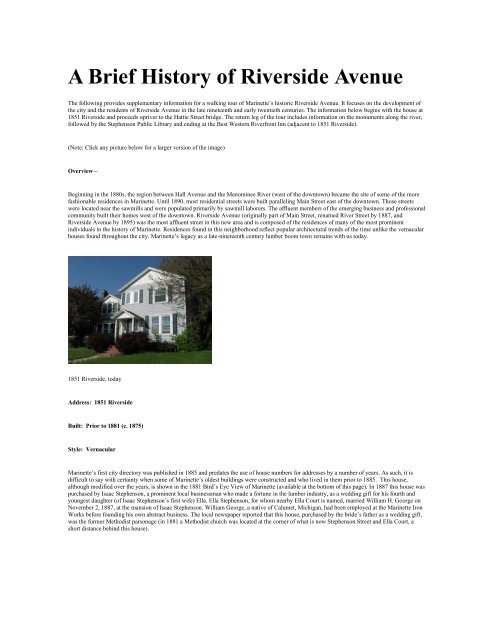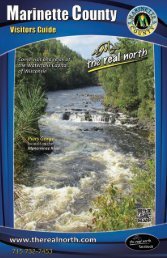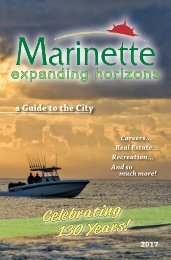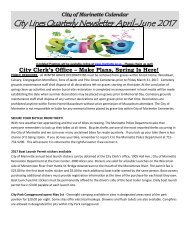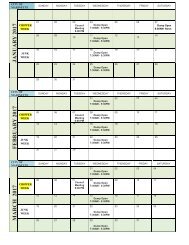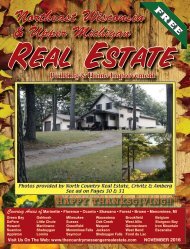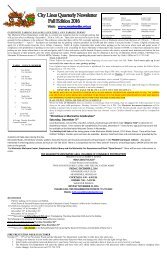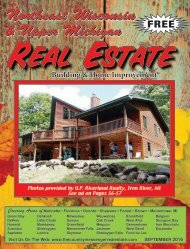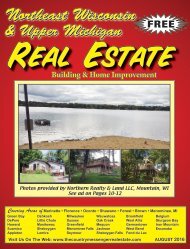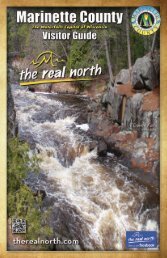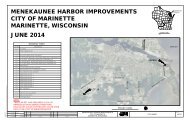A_Brief_History_of_Riverside
Create successful ePaper yourself
Turn your PDF publications into a flip-book with our unique Google optimized e-Paper software.
A <strong>Brief</strong> <strong>History</strong> <strong>of</strong> <strong>Riverside</strong> Avenue<br />
The following provides supplementary information for a walking tour <strong>of</strong> Marinette’s historic <strong>Riverside</strong> Avenue. It focuses on the development <strong>of</strong><br />
the city and the residents <strong>of</strong> <strong>Riverside</strong> Avenue in the late nineteenth and early twentieth centuries. The information below begins with the house at<br />
1851 <strong>Riverside</strong> and proceeds upriver to the Hattie Street bridge. The return leg <strong>of</strong> the tour includes information on the monuments along the river,<br />
followed by the Stephenson Public Library and ending at the Best Western Riverfront Inn (adjacent to 1851 <strong>Riverside</strong>).<br />
(Note: Click any picture below for a larger version <strong>of</strong> the image)<br />
Overview –<br />
Beginning in the 1880s, the region between Hall Avenue and the Menominee River (west <strong>of</strong> the downtown) became the site <strong>of</strong> some <strong>of</strong> the more<br />
fashionable residences in Marinette. Until 1890, most residential streets were built paralleling Main Street east <strong>of</strong> the downtown. Those streets<br />
were located near the sawmills and were populated primarily by sawmill laborers. The affluent members <strong>of</strong> the emerging business and pr<strong>of</strong>essional<br />
community built their homes west <strong>of</strong> the downtown. <strong>Riverside</strong> Avenue (originally part <strong>of</strong> Main Street, renamed River Street by 1887, and<br />
<strong>Riverside</strong> Avenue by 1895) was the most affluent street in this new area and is composed <strong>of</strong> the residences <strong>of</strong> many <strong>of</strong> the most prominent<br />
individuals in the history <strong>of</strong> Marinette. Residences found in this neighborhood reflect popular architectural trends <strong>of</strong> the time unlike the vernacular<br />
houses found throughout the city. Marinette’s legacy as a late-nineteenth century lumber boom town remains with us today.<br />
1851 <strong>Riverside</strong>, today<br />
Address: 1851 <strong>Riverside</strong><br />
Built: Prior to 1881 (c. 1875)<br />
Style: Vernacular<br />
Marinette’s first city directory was published in 1885 and predates the use <strong>of</strong> house numbers for addresses by a number <strong>of</strong> years. As such, it is<br />
difficult to say with certainty when some <strong>of</strong> Marinette’s oldest buildings were constructed and who lived in them prior to 1885. This house,<br />
although modified over the years, is shown in the 1881 Bird’s Eye View <strong>of</strong> Marinette (available at the bottom <strong>of</strong> this page). In 1887 this house was<br />
purchased by Isaac Stephenson, a prominent local businessman who made a fortune in the lumber industry, as a wedding gift for his fourth and<br />
youngest daughter (<strong>of</strong> Isaac Stephenson’s first wife) Ella. Ella Stephenson, for whom nearby Ella Court is named, married William H. George on<br />
November 2, 1887, at the mansion <strong>of</strong> Isaac Stephenson. William George, a native <strong>of</strong> Calumet, Michigan, had been employed at the Marinette Iron<br />
Works before founding his own abstract business. The local newspaper reported that this house, purchased by the bride’s father as a wedding gift,<br />
was the former Methodist parsonage (in 1881 a Methodist church was located at the corner <strong>of</strong> what is now Stephenson Street and Ella Court, a<br />
short distance behind this house).
1851 <strong>Riverside</strong>, c. 1900<br />
Ella, William, and their son, Howard Stephenson George (b. 1888), lived here until 1897 when Isaac Stephenson purchased the house next door,<br />
1857 <strong>Riverside</strong>, as a gift for his daughter and son-in-law. 1851 <strong>Riverside</strong> was then purchased by Dr. Fred G. Colter, a leading physician and<br />
surgeon in Marinette. Dr. Colter resided here until sometime between 1913 and 1920, at which time his brother, Dr. Roy B. Colter, a prominent<br />
local dentist, made the house his home. Dr. Roy Colter continued to live here until his death in 1949. Dr. Roy and his wife, Lillian (nee Lindem),<br />
had a daughter, Margaret. Margaret Colter grew up in the house and, in time, became the maternal grandmother <strong>of</strong> Hollywood actress Winona<br />
Ryder.<br />
In later years, noted local theatre director Herb Williams is said to have rented an apartment in this house.<br />
1857 <strong>Riverside</strong>, today<br />
Address: 1857 <strong>Riverside</strong><br />
Built: 1881<br />
Style: Queen Anne<br />
According to the local newspaper, this house, and its twin next door at 1863 <strong>Riverside</strong>, were among the city’s first “fashionable” houses to be<br />
built. Noted local builder John Crockett began construction on this house in May <strong>of</strong> 1881 and finished the work during the week <strong>of</strong> Thanksgiving<br />
later that year. A pair <strong>of</strong> identical houses are depicted in the 1881 Bird’s Eye View <strong>of</strong> Marinette at the site <strong>of</strong> 1857 & 1863 <strong>Riverside</strong>, but these two<br />
houses were under construction as the Bird’s Eye View was being created. As such, the small buildings shown on the Bird’s Eye View<br />
likely represent the in-process construction <strong>of</strong> these two houses. Architecturally, the two houses appear to be based on the “Model Gothic Cottage”<br />
design in the 1878 pattern book Palliser’s Model Homes. Individual architectural details were copied directly from another pattern book,<br />
Woodward’s National Architect <strong>of</strong> 1869.<br />
The house at 1857 <strong>Riverside</strong> was built for Charles & Jennie Fairchild. Charles, born in 1850 in Knightstown, Indiana, came to Marinette in<br />
1863. He went to work at his brother Addison’s drug store as clerk in 1870 and became a full partner in the “Fairchild Bros” drug store in 1872.<br />
The partnership lasted until 1887 when Charles sold his interest in “the drug” and purchased the North Star newspaper. Charles also kept busy<br />
with a number <strong>of</strong> secondary pursuits–he served as town treasurer, was a member <strong>of</strong> the library board <strong>of</strong> directors, established Marinette’s first<br />
electric-light plant, managed the “Marinette baseball club,” and enjoyed music and bicycling. Charles and Jennie had four children, Edna (b.<br />
1876), Horace (b. 1881, d. 1882), Oakalla (b. 1882), and Willard (b. 1886). The family lived here until late 1896 when they moved to Toledo,<br />
Ohio, where Charles was president <strong>of</strong> the Standard Steel Tube and Forkside Company. The Fairchilds sold the house to Isaac Stephenson who then<br />
gave the property to his daughter Ella (see 1851 <strong>Riverside</strong> above).
1857 <strong>Riverside</strong>, in 1898<br />
Ella and William George made use <strong>of</strong> some <strong>of</strong> the additional space in their larger home with the birth <strong>of</strong> their second son, Isaac Stephenson<br />
George, in 1899. The larger, wrap-around porch was added around 1905. Ella died in 1908 and, by the time it was sold in 1918, the house had<br />
fallen into a state <strong>of</strong> disrepair.<br />
The third owners <strong>of</strong> 1857 <strong>Riverside</strong> were Frank and Bertha Erdlitz. Frank, a former mayor <strong>of</strong> Menominee, Michigan, was the secretary and<br />
treasurer <strong>of</strong> the Menominee River Brewing Company (Menominee-Marinette Brewing Company after prohibition ended in 1933) and eventually<br />
served as president <strong>of</strong> that enterprise. The move to Marinette may have been spurred by Prohibition taking effect in Michigan a short time before it<br />
became law in Wisconsin. Frank Erdlitz also owned the Dunlap Square Building (note the Menominee River Brewing Co. logos in the turret<br />
windows <strong>of</strong> that building) and this house on <strong>Riverside</strong> may have been advantageous for its proximity to that building.<br />
Frank and Bertha had twelve children. Helen Erdlitz, the youngest <strong>of</strong> the twelve, was born in 1909. Following the deaths <strong>of</strong> her parents in 1935<br />
and 1937, Helen continued to live at 1857 <strong>Riverside</strong> until 1989. Additional, in-depth information on this house is available here.<br />
1863 <strong>Riverside</strong>, today<br />
Address: 1863 <strong>Riverside</strong><br />
Built: 1881<br />
Style: Queen Anne<br />
This house, built as a near twin <strong>of</strong> 1857 <strong>Riverside</strong>, was originally the home <strong>of</strong> Addison M. Fairchild and Maria E. Fairchild (nee Wright).<br />
Addison was born in Newton, Indiana, in 1843. In 1863 he enlisted with the 75th Indiana Volunteer Infantry, which participated in a number <strong>of</strong><br />
engagements as well as General Sherman’s March to the Sea, and came to Marinette following his discharge in 1865. He worked as a bookkeeper<br />
for the N. Ludington Company until 1868 when he engaged in the drug business with Dr. Hall. He was joined by his brother Charles (see 1857<br />
<strong>Riverside</strong>) in 1870, and the resulting partnership would last until 1887. Addison continued in the drug business until his death in 1898. In addition<br />
to his work as a pharmacist, Addison served for sixteen years as Marinette’s Chief <strong>of</strong> the Fire Department. Addison was also president <strong>of</strong> the<br />
school board and was Marinette’s first telephone operator (Marinette got its first phones in June <strong>of</strong> 1881–Addison was the first manager and ran<br />
the original telephone exchange out <strong>of</strong> the pharmacy).
1863 <strong>Riverside</strong>, c. 1896 (1857 <strong>Riverside</strong> in background, at left)<br />
Addison and Maria had three children, Maud (b. 1870, d. 1889), William Richard (b. 1872), and Pauline (b. 1879, d. 1902). Following the death <strong>of</strong><br />
Maria in 1885, Addison married Phyllis Brown (one <strong>of</strong> Marinette’s early telephone operators) in 1891, and their son Stafford Brown Fairchild was<br />
born in 1895.<br />
Phyllis died unexpectedly in 1899 and the house was sold to Charles S. Brown, a son <strong>of</strong> notable Marinette lumberman Augustus C. Brown. By<br />
1909 the house was owned by Earl and Myrtle Heath. Earl is best remembered for his proprietorship <strong>of</strong> the Hotel Marinette, which he sold in 1929.<br />
The Heath family altered the home–between 1910 and 1921 the two-story front addition that you see today was constructed. Myrtle continued to<br />
live in this house after Earl’s death in 1951.<br />
1903 <strong>Riverside</strong>, today<br />
Address: 1903 <strong>Riverside</strong><br />
Built: c. 1895<br />
Style: Queen Anne<br />
Although shown on the 1895 Sanborn map for Marinette, 1903 <strong>Riverside</strong> first appears in the city directory in 1897 with pioneer businessman<br />
William S. Baker as its first occupant. William Baker was born in Fort Edward, New York, in 1847, and came to Menominee in 1867. He worked<br />
as a bookkeeper for R. Stephenson & Company until 1871, then with Hamilton, Merryman & Company in Marinette until 1874. Following this he<br />
commenced his insurance business with which he remained and prospered for over fifty years before his death in 1928. He was also one <strong>of</strong> the two<br />
supervisors <strong>of</strong> Marinette County when it was first created in 1879 and served in that capacity for a number <strong>of</strong> years. In 1880 he was elected<br />
Marinette Town Chair.
1903 <strong>Riverside</strong>, c. 1900<br />
William Baker married Sarah J. Stephenson, a half-sister <strong>of</strong> Isaac Stephenson, in 1870. They had four children (Harvey, Fred, Bertha, and E.<br />
Judson). Sarah died in 1884 and William married Myrtie Gifford in 1887.<br />
By 1935 Clarence W. Nordin resided here. Born in Marinette in 1889, Clarence attended Marinette schools and, during WWI, served in the<br />
Canadian Army. Clarence was an employee <strong>of</strong> the Michigan Inspection Bureau since 1929.<br />
Sometime between 1941 and 1946 the house became the home <strong>of</strong> Dr. Harold Stark. Harold was born in 1912 and came to Marinette in 1938 where<br />
he practiced dentistry until retiring in 1978. Harold served in the Army in Korea from 1953 to 1955.<br />
This house was originally built with a larger wrap-around front porch. The house was converted into a duplex in the 1930s and the stucco siding<br />
was likely added at that time–the original clapboard and shingle siding reportedly remain under the current exterior. There are five stained glass<br />
windows on the first floor (one is curved) and two in the attic.<br />
1907 <strong>Riverside</strong>, today<br />
Address: 1907 <strong>Riverside</strong><br />
Built: c. 1901<br />
Style: Foursquare<br />
An earlier house at this address was once home to William S. Baker. In 1895 William Baker had moved to a new house at 1903 <strong>Riverside</strong>. The old<br />
house at 1907 <strong>Riverside</strong> was likely replaced around 1901. At this time the city directories list Erastus J. Baker, son <strong>of</strong> William, as the owner.<br />
Erastus engaged in the insurance business with his father until he moved away from the area around 1912.<br />
In 1920 the city directory lists Michael J. Culnan at 1907 <strong>Riverside</strong>. Michael Culnan was born in Memphis, Michigan, in 1856. By 1870 he began<br />
clerking and, in 1886, started a dry goods store in Calumet, Michigan. He came to Marinette in 1897, engaged in similar business, and later was<br />
associated with the Skidmore Land Company before associating himself with the Lauerman Brothers Store where he became general<br />
superintendent.
Michael Culnan married Catherine Belanger in Detroit in 1884. They had four children (Edgar, John, Ralph, and Catherine). Mrs. Culnan<br />
remained in the house for several years after her husband’s death in 1926. Her 1931 obituary notes that she was a “highly cultured woman, devoted<br />
to home and family, she led a quiet life at home.”<br />
By 1935 the house had been passed to Alphonse J. DeLeers and would remain his until his death. Alphonse was a prominent businessman who<br />
worked for the Lauerman firm for 53 years as a certified public accountant and manager <strong>of</strong> the credit department until his death in 1966. He was<br />
also a founder <strong>of</strong> the Marinette County Historical Society in 1932, a member <strong>of</strong> the board <strong>of</strong> trustees <strong>of</strong> Marinette General Hospital, president <strong>of</strong><br />
the Marinette Area Chamber <strong>of</strong> Commerce, and chairman <strong>of</strong> the board <strong>of</strong> directors <strong>of</strong> Little River Country Club. Alphonse’s wife Gretchen was a<br />
member <strong>of</strong> the Catholic Woman’s Club and <strong>of</strong> the altar society <strong>of</strong> Our Lady <strong>of</strong> Lourdes Church. The couple had four daughters and two sons (one<br />
was Rev. Vincent DeLeers, dean <strong>of</strong> St. Norbert College at DePere).<br />
1919 <strong>Riverside</strong>, today<br />
Address: 1919 <strong>Riverside</strong><br />
Built: 1885<br />
Style: Queen Anne<br />
Like the houses <strong>of</strong> the Fairchild Brothers, this house and the one next to it at 1931 <strong>Riverside</strong> were built as twins <strong>of</strong> one another. The two houses<br />
were commissioned by Isaac Stephenson as wedding gifts for his two eldest daughters. The architect was J. B. Sweat, <strong>of</strong> Marquette, Michigan. The<br />
house at 1919 retains much <strong>of</strong> its Queen Anne styling (see also the picture for 1931 <strong>Riverside</strong> below), but the newer siding and windows are not as<br />
ornate as those which were originally installed. The original color scheme in 1885 was pea green and red.<br />
On May 20, 1884, Isaac Stephenson’s second daughter, Maggie, married Joshua Hodgins, a young partner in the Marinette hardware firm <strong>of</strong><br />
Hodgins, Spicer and Co. Joshua was born in 1856 in Kincardine, Bruce County, Ontario, Canada. He came to Marinette in 1873, working in the<br />
tinner’s trade for Watson Brothers until 1881 when he entered Milton College in Milton, Wisconsin. From 1883 until 1887 Joshua engaged in the<br />
hardware business in Marinette before moving into the coal business. That coal business would eventually merge into the Standard Oil Company<br />
and Joshua would continue with the firm until retiring in 1894. In 1891 he was appointed chief <strong>of</strong> the Marinette Fire Department.
1919 <strong>Riverside</strong>, c. 1900<br />
General Joshua Hodgins also had a distinguished military career with the local National Guard unit. With Colonel W. P. Greene he helped to form<br />
Marinette’s Company I in 1884 and served as one <strong>of</strong> its <strong>of</strong>ficers. He was first lieutenant when the company mustered into the Wisconsin National<br />
Guard in 1889, a position which he held when the company left for the Spanish American War in 1898. The unit saw active service against<br />
Spanish forces in Puerto Rico and during the conflict Joshua was promoted to Captain. He was appointed quartermaster general by Governor La<br />
Follette, a position which he would hold for over ten years.<br />
General Hodgins died in 1919, but Maggie remained in the house until her death in 1935. Maggie had been very active in club work. She was a<br />
past president <strong>of</strong> the <strong>of</strong> the State Federation <strong>of</strong> Women’s Clubs, chairman <strong>of</strong> the National Federation <strong>of</strong> Women’s Clubs house committee,<br />
president <strong>of</strong> the Marinette Women’s Club, and was honorary president <strong>of</strong> the Marinette County Federation as well as the Marinette County<br />
Historical Society. She assisted in the organization <strong>of</strong> the Marinette County Chapter <strong>of</strong> the American Red Cross, she was commissioner <strong>of</strong> the<br />
local Girl Scout organization, and she was first vice president <strong>of</strong> the Civic Music Association.<br />
Over the course <strong>of</strong> the following ten years no fewer than three other individuals lived here. By 1946 the house was the home <strong>of</strong> the Staudenmaier<br />
family. Louis Staudenmaier became president <strong>of</strong> the Stephenson National Bank in 1959 and would be succeeded in that post by his daughter Mary<br />
in 1979.<br />
1931 <strong>Riverside</strong>, today<br />
Address: 1931 <strong>Riverside</strong><br />
Built: 1885, remodel c. 1925<br />
Style: Tudor Revival<br />
Originally a twin <strong>of</strong> 1919 <strong>Riverside</strong>, this house was extensively remodeled, with an exterior makeover in the fashionable Tudor Revival style<br />
sometime between 1923 and 1929 that included the addition <strong>of</strong> the large sun porch. The house was added to the Wisconsin State Register <strong>of</strong><br />
Historic Places in May <strong>of</strong> 2015 and to the National Register <strong>of</strong> Historic Places on October 5, 2015, based on its architectural significance as an<br />
excellent local example <strong>of</strong> the Tudor Revival style. (Fairchild & Flatt did the State & National Register nomination paperwork.)<br />
The eldest daughter <strong>of</strong> Isaac Stephenson, Mary, was also the first <strong>of</strong> his daughters to get married. On November 6, 1883, Mary and Harry J. Brown<br />
were wed at Isaac Stephenson’s mansion. Following a brief honeymoon the couple returned and supervised the construction <strong>of</strong> this house.
1931 <strong>Riverside</strong>, c. 1885<br />
Mary was born in Marinette in 1862 and, as an adult, was active with her church, the Woman’s club, and the local Girl Scout Council. Harry, born<br />
in Racine, Wisconsin, in 1861, began his lifelong banking career in 1877 when he became a clerk at the Stephenson Banking Company in<br />
Marinette. This bank was incorporated by Mary’s father, Isaac Stephenson, in 1874 and became the Stephenson National Bank in 1889. Harry<br />
went on to become the cashier <strong>of</strong> the Stephenson National Bank in 1891 and president <strong>of</strong> the bank in 1920, a position that he would retain until his<br />
death. Harry was a director <strong>of</strong> the Escanaba and Lake Superior Railroad Company, the Stephenson National Bank, and the Marine National<br />
Exchange Bank <strong>of</strong> Milwaukee. Additionally, Harry was a Mason, charter member <strong>of</strong> Marinette’s Rotary Club, a member <strong>of</strong> the Marinette Elks<br />
lodge, a member <strong>of</strong> the library board, and a leader in the activities <strong>of</strong> the local Boy and Girl Scouts. Both Mary and Harry would live in this house<br />
continuously from 1885 until their deaths in 1936 and 1938, respectively. Mary and Harry Brown had no children. Following the tenure <strong>of</strong> the<br />
Browns, the house served as the home <strong>of</strong> the Henry Campbell family and, later yet, the home <strong>of</strong> the Chester Stauffacher family.<br />
1947 <strong>Riverside</strong>, today<br />
Address: 1947 <strong>Riverside</strong><br />
Built: 1959 (education building) & 1967 (church)<br />
Style: Mid-century modern (church)<br />
Organized in 1863, Pioneer Presbyterian was Marinette’s first established church with a permanent pastor. Reverend John Fairchild and his wife<br />
Laura Porter Fairchild (nee Bigelow)–Charles & Addison’s parents (1857 <strong>Riverside</strong> & 1863 <strong>Riverside</strong>)–moved their family from Wabash, Indiana,<br />
to Marinette in May <strong>of</strong> 1863. A synopsis <strong>of</strong> the church’s history can be found on the Pioneer Presbyterian website here.
1947 <strong>Riverside</strong>, 1898<br />
Prior to the church relocating to this site, 1947 <strong>Riverside</strong> was the address <strong>of</strong> Isaac Stephenson, pioneer lumberman, U.S. Congressman (1883-<br />
1889), and U.S. Senator (1907-1915). Born in 1829 in Yorkton, near Fredericton, York County, New Brunswick (Canada), Isaac came to<br />
Marinette in 1858. In time he would amass a fortune from his association with the N. Ludington Company. His brick mansion was built from July<br />
1882 to 1883 by Chicago builder William B. McNeil. The mansion, in the Second Empire style, was massive.<br />
Delbridge house, 1947 <strong>Riverside</strong>, courtesy <strong>of</strong> Pioneer Presbyterian via Guy Rondeau<br />
The mansion was razed by James Delbridge in 1920, reportedly in the wake <strong>of</strong> a fire. James, president and general manager <strong>of</strong> the Marinette &<br />
Menominee Paper Co., built a fine brick home on the site. His wife was the founder <strong>of</strong> the Oconto Falls Woman’s Club and was active in the<br />
DAR, the PEO, Eastern Star, and the Needlework Guild. By 1938 Ralph Skidmore had purchased the Delbridge home. In 1904 Ralph Skidmore<br />
married Harriet Stephenson, the daughter <strong>of</strong> Isaac Stephenson and Ike’s second wife, Harriet. Ralph Skidmore formed the Skidmore Abstract and<br />
Land Co. in 1910 and worked in that capacity for a quarter-century. He was also the president <strong>of</strong> the Peshtigo Dairy Co. until that firm was<br />
purchased by the Fairmont Co. Like the Stephenson mansion before it, this house was extensively damaged by fire in 1972 and subsequently<br />
razed.<br />
1961 <strong>Riverside</strong>, c. 1902<br />
The church sanctuary is situated where the Fred Carney home at 1961 <strong>Riverside</strong> once stood. Frederick Carney was born around 1836 in New<br />
Brunswick, Canada, and went to Maine at the age <strong>of</strong> 14. In 1855 he was hired on by Daniel Wells Jr. to work the woods on the Escanaba River and<br />
came to Marinette in 1856 to erect the mill <strong>of</strong> the N. Ludington Company, at which time he was, according to his 1899 obituary, earning $18 per<br />
month. In 1868 he purchased an interest and became the superintendent and general manager <strong>of</strong> the H. Witbeck Co., a position which he held until
his death in 1899. Fred Carney’s brick home, built by the same William B. McNeil who was to build the Isaac Stephenson mansion, was<br />
completed in 1882. Although smaller in scale than Isaac Stephenson’s mansion, this Second Empire style home was, nonetheless, very impressive.<br />
1961 <strong>Riverside</strong> would remain in the Carney family until the death <strong>of</strong> Mrs. Elizabeth Carney, Fred’s widow, in 1914. Elizabeth’s obituary notes that<br />
she was a woman <strong>of</strong> strong character, “most kindly in heart, devoted to her family and the cause <strong>of</strong> charity found in her a liberal response.” By<br />
1920 the house belonged to Charles J. Lauerman who, with his brothers Frank and Joseph, was a member <strong>of</strong> the Lauerman Brothers Company (a<br />
successful department store chain in the early & mid-20th century – note the Lauerman Department Store Building on Dunlap Square in<br />
downtown Marinette). Listed as vacant in 1946, the house was razed in 1949.<br />
1975 <strong>Riverside</strong>, today<br />
Address: 1975 <strong>Riverside</strong><br />
Built: 1910<br />
Style: Georgian Revival<br />
Architecturally significant, the design <strong>of</strong> this house is a product <strong>of</strong> nationally renowned architect George F. Barber <strong>of</strong> Knoxville, Tennessee.<br />
Barber’s late-19th- and early-20th-century residential designs are found across the country thanks primarily to his series <strong>of</strong> mail-order catalogs.<br />
This house is a variant <strong>of</strong> “Design No. 1” in Barber’s 1901 publication Modern Dwellings: A Book <strong>of</strong> Practical Designs and Plans for Those Who<br />
Wish to Build or Beautify Their Homes (also pictured on the cover <strong>of</strong> that book). This particular example was built without the larger porch<br />
pictured in Barber’s book, but the neoclassical porch on this house is still monumental in scale. Although not yet listed on the National Register <strong>of</strong><br />
Historic Places, this house is considered eligible for listing.<br />
1975 <strong>Riverside</strong>, c. 1910<br />
1975 <strong>Riverside</strong> was built in 1910 for Joseph and Cecelia Lauerman. Joseph Albert Jacob Lauerman was born in Muscoda, Wisconsin, in 1866.<br />
When he was 15 years old he entered the business arena and, at age 23, came to Marinette and opened a store on Main Street. Joseph’s younger<br />
brother, Frank, was a silent partner in the venture and provided financial support from Muscoda. The Marinette venture quickly proved to be<br />
successful and within two years Frank came to Marinette to work alongside his brother. A few years later brother Charles came to Marinette and<br />
also became associated with the Lauerman Brothers Co.
Joseph married Amelia Bezio in 1892, with whom he had two children. Amelia died in 1894. Joseph married Cecelia Kellerman in 1901 and from<br />
this union six children were born. Joseph died in 1922, but Cecelia continued to live at 1975 <strong>Riverside</strong> until her death in 1954. Cecelia was a<br />
charter member <strong>of</strong> the Catholic Woman’s Club, a member <strong>of</strong> the Lourdes Altar Society, the Lourdes Alumni, and was a Franciscan Tertiary.<br />
2115 <strong>Riverside</strong>, today<br />
Address: 2115 <strong>Riverside</strong><br />
Built: c. 1899<br />
Style: Foursquare<br />
2115 <strong>Riverside</strong>, an impressive early American foursquare house, first appears in the city directories as the home <strong>of</strong> Irenus K. Hamilton Jr. in 1899.<br />
Irenus Kittredge Hamilton (Senior) was born in 1830 in Lyme, New Hampshire, and came to Fond du Lac, Wisconsin, in 1855 where he and his<br />
brother erected a sawmill and engaged in the lumber business for twelve years. In 1868 they sold their interests in the Fond du Lac sawmill and, in<br />
connection with Mr. A. C. Merryman, erected a gang and circular mill at Marinette. That mill became a corporation in 1873 under the name <strong>of</strong><br />
Hamilton & Merryman Company.<br />
2115 <strong>Riverside</strong>, c. 1902<br />
I. K. Hamilton Jr., for whom this house was built, went to college and became an “electrician” (electrical engineer in today’s terms). Early in his<br />
career he went to work with the Hamilton & Merryman Company, serving as Secretary <strong>of</strong> that enterprise for a number <strong>of</strong> years before returning to<br />
New England sometime between 1907 and 1909. Once back east, I. K. Hamilton Jr. associated himself with the Automatic Refrigerating<br />
Company. By 1917 he was president and treasurer <strong>of</strong> that company.<br />
As <strong>of</strong> 1909 this house was the home <strong>of</strong> George A. Mitcheson (senior, I think, born in 1860). By 1920 he was the president <strong>of</strong> the Mitcheson<br />
Lumber Co. and secretary <strong>of</strong> the Brown-Mitcheson Lumber Company. His children included a son, George Arthur Mitcheson Jr., who was born in<br />
1895 and served with the ambulance corp in France during WWI. Research on this property is complicated to some degree given that George A.<br />
Mitcheson senior shared a name with his son, and this is further complicated by records that show BOTH George Mitchesons (senior and junior)<br />
died in 1920. George A. Mitcheson (junior, as best I can discern) suffered a sunstroke in the summer <strong>of</strong> 1920 while supervising the construction <strong>of</strong><br />
a new sawmill. This was reported to be a possible contributing factor in his tragic decision to take his own life the following month, leaving behind<br />
a widow and two young children. Nonetheless, George A. Mitcheson Sr.’s widow, Clara, placed blame for the death <strong>of</strong> her son upon her son’s<br />
widow, Dorothy. This ultimately led to a not-so-private court case in 1935 in which Dorothy unsuccessfully challenged Clara’s will and
testament (Clara having died in 1932). That will reportedly excluded Dorothy and her two children (Clara’s grandchildren) from inheriting a<br />
significant portion <strong>of</strong> the Mitcheson estate.<br />
For a few years following the death <strong>of</strong> George Mitcheson (junior & senior) this house was the home <strong>of</strong> Herman G. Weber. By 1926 it was the<br />
home <strong>of</strong> Dr. Theodore R. Michaelis. Dr. Michaelis was born in 1874 in Shullsburg, Wisconsin, and graduated from the Chicago College <strong>of</strong> Dental<br />
Surgery in 1895. He came to Marinette in 1897 where he practiced dentistry for the next 35 years. He was the owner <strong>of</strong> the Little River Golf<br />
Course and, in addition to many other pursuits, was a charter member and past president <strong>of</strong> the Marinette Lions Club. Dr. Michaelis died in 1936<br />
and his widow continued to live here for another decade.<br />
By 1949 Mr. Raymond Lauerman called 2115 <strong>Riverside</strong> his home and would continue to do so until his death in 1989. Raymond Lauerman was<br />
the son <strong>of</strong> Frank and Nell Lauerman. Born in 1896, Raymond served in the U.S. Navy during WWI. He managed the Lauerman Store in Waterloo,<br />
Wisconsin, in the late 1920s, returned to Marinette in 1930, and married Neva H. Lange in 1931. Raymond Lauerman was secretary for the<br />
Lauerman Bros. Company (and later chairman <strong>of</strong> the board <strong>of</strong> that company), vice president <strong>of</strong> the Madigan-Lauerman Real Estate Co., and c<strong>of</strong>ounder<br />
and past president <strong>of</strong> the Little River Country Club (he headed a group that purchased control <strong>of</strong> the club from Mrs. Michaelis in 1940),<br />
among other pursuits. Raymond and Neva had two children.<br />
2125 <strong>Riverside</strong>, today<br />
Address: 2125 <strong>Riverside</strong><br />
Built: 1895<br />
Style: Queen Anne<br />
This house was built in 1895 for Fred Carney Jr., son <strong>of</strong> prominent lumber industry businessman Fred Carney Sr. (see 1961 <strong>Riverside</strong>). Fred<br />
Carney Jr. was born in Marinette in 1870 and engaged in the lumber business and operated the Twin City Ice Co.<br />
2125 <strong>Riverside</strong>, c. 1902<br />
Fred Carney and his wife Nellie Carroll Carney lived here from 1895 until sometime between 1913 and 1920. By 1920 this was the home <strong>of</strong> Harry<br />
L. Haslanger. Harry Haslanger, a native <strong>of</strong> South Bend, Indiana, came to Menominee in 1916 and was the manager <strong>of</strong> the Peninsular Box and<br />
Lumber Company and general manager <strong>of</strong> the Marinette and Menominee Box Company. In 1918 he became a director <strong>of</strong> the Stephenson National<br />
Bank and, in 1927 he became vice president <strong>of</strong> the bank after selling the box company. Following the death <strong>of</strong> Harry Brown in 1938 (see 1931
<strong>Riverside</strong>), Harry Haslanger became the president <strong>of</strong> the Stephenson National Bank–serving in that capacity (and living at 2125 <strong>Riverside</strong>) until<br />
his death in 1952.<br />
Prior to the construction <strong>of</strong> this house in 1895, this was the site <strong>of</strong> Queen Marinette’s house. Built around 1838, Queen Marinette’s house was the<br />
first frame dwelling on the Menominee River.<br />
2141 <strong>Riverside</strong>, today<br />
Address: 2141 <strong>Riverside</strong><br />
Built: c. 1938<br />
Style: International Style<br />
The 1933 Chicago World’s Fair included “the Homes <strong>of</strong> Tomorrow Exhibition”. Among those who visited this 1933-1934 exhibition was Frank J.<br />
Lauerman Jr. Frank’s father, Frank Sr., appreciated the information that his son had acquired concerning modern architecture and had this house<br />
constructed on a small lot along <strong>Riverside</strong> Avenue. This house is architecturally significant as Marinette’s only International Style (see also<br />
“Bauhaus”) house. The house retains a high degree <strong>of</strong> architectural integrity and is considered to be eligible for listing in the National Register <strong>of</strong><br />
Historic Places.<br />
In 1946 this house was the residence <strong>of</strong> Joseph D. Mackin. Joseph Mackin was the general manager <strong>of</strong> WMAM Radio and Channel 11 television<br />
in Marinette (precursor to today’s WLUK Channel 11 in Green Bay). Joseph Mackin was also a past president <strong>of</strong> the Marinette Area Chamber <strong>of</strong><br />
Commerce. Interestingly, Frank Lauerman Sr. was responsible for the construction <strong>of</strong> the WMAM building, and it is no coincidence that the<br />
WMAM building was built in the Art Moderne style (similar to International Style), which is also a rarity in Marinette.<br />
2153 <strong>Riverside</strong>, today
Address: 2153 <strong>Riverside</strong><br />
Built: 1902<br />
Style: Georgian Revival<br />
2153 <strong>Riverside</strong> was built for I. Watson Stephenson, elder son <strong>of</strong> lumberman Isaac Stephenson (1947 <strong>Riverside</strong>). Born in 1877, Watson graduated<br />
from the Orchard Lake Military Academy in 1897. He was on the staff <strong>of</strong> Governor Sc<strong>of</strong>ield, Governor La Follette, and Governor Davidson, as<br />
well as the general manager <strong>of</strong> the N. Ludington Company and chairman <strong>of</strong> the Marinette County Drainage board. Watson married Katherine<br />
McLaughlin in 1900 and the couple had two children.<br />
2153 <strong>Riverside</strong>, c. 1902<br />
Colonel I. Watson Stephenson died in 1910 following a year-and-a-half long struggle with tuberculosis. He had a sun parlor annex built to his<br />
<strong>Riverside</strong> home (the semi-circular room still present) where he spent his final days. Survivors included five sisters, Mrs. Maggie Hodgins (1919<br />
<strong>Riverside</strong>), Mrs. Mary Brown (1931 <strong>Riverside</strong>), Mrs. Georgiana Ludington (Chicago, Illinois), Mrs. Earl Morgan (Oshkosh, Wisconsin), and Mrs.<br />
Ralph Skidmore (1947 <strong>Riverside</strong>), and brother Grant Stephenson. Katherine Stephenson, his widow, continued to live here, last listed at this<br />
address in the 1935 city directory (at the time <strong>of</strong> her death in 1958 she resided at 114 Hattie Street).<br />
By 1938 this was the home <strong>of</strong> Edgar Habighorst, president and resident manager <strong>of</strong> American Excelsior Co. In 1941 this was the home <strong>of</strong> Francis<br />
Hood, president and founder <strong>of</strong> the Ansul Chemical company.<br />
2157 <strong>Riverside</strong>, today<br />
Address: 2157 <strong>Riverside</strong><br />
Built: 1888<br />
Style: Dutch Colonial Revival<br />
This building was built as the <strong>of</strong>fice <strong>of</strong> the Menominee River Boom Company, <strong>of</strong> which Isaac Stephenson was the principal owner. This company<br />
was responsible for sorting the logs on the river through its river booms (a book on this company is available online here, as well as at the
Stephenson Public Libary). By 1897 this building housed the <strong>of</strong>fices <strong>of</strong> the Marinette Business Men’s Association and the Marinette & Western<br />
Railway Co., in addition to the Menominee River Boom Company. In 1899 the <strong>of</strong>fice <strong>of</strong> the Northern Chataqua Assembly was also here. From<br />
1909 until 1922 the building’s only listed occupant was the Menominee River Boom Company; however, it is shown on the 1921 Sanborn map as<br />
being used for general storage for the then-nearby M & M Paper Company.<br />
2157 <strong>Riverside</strong>, c. 1896<br />
Dan J. Madagin purchased this building, had it moved a short distance further away from the road, and adapted it to become his home. Born in<br />
Marinette in 1864, Dan Madagin was the son <strong>of</strong> Irish immigrants who operated the Marinette House (located on Main Street in way <strong>of</strong> the present<br />
Lauerman building). As a youth Dan took a job at a billiard parlor on Main Street, followed by work in the woods for the lumber companies and, a<br />
short time later, owned a restaurant on Dunlap Square. He went on to own a second restaurant, then an interest in a livery business, followed by<br />
time spent as a traveling salesman for Lindquist, Westman, and Campbell. In 1895 Dan Madagin organized a real estate business that evolved into<br />
the Madagin and Lauerman real estate firm. In 1914 he incorporated the firm <strong>of</strong> Duxbury and Madagin. That firm became the Madagin Insurance<br />
agency.<br />
Dan Madagin was an alderman and president <strong>of</strong> the city council (in Marinette) during Mayor W. C. Campbell’s time in <strong>of</strong>fice at the turn <strong>of</strong> the last<br />
century. For eight years as a young man he served on the Marinette Fire Department, working with fire chief Addison Fairchild (1863 <strong>Riverside</strong>).<br />
Dan Madagin died at his home in 1946. His wife, who died in 1943, had been a member <strong>of</strong> Our Lady <strong>of</strong> Lourdes church, the Altar Society, and the<br />
Catholic Woman’s Club.<br />
Erdlitz-Hattie Street Bridge, c. 1915<br />
Address: Corner, Hattie Street & <strong>Riverside</strong><br />
Built: 1912 (original)<br />
Style: Steel Reinforced Concrete (current)<br />
In 1894 a third bridge was built connecting Menominee, Michigan, and Marinette, Wisconsin. That bridge was built above the dam and it was<br />
replaced in 1912 with an iron truss bridge at this site, below the dam. It has been replaced and upgraded a number <strong>of</strong> times since 1912. Prior to<br />
Menominee’s streets being renamed after historically significant numbers, 26th Street bore the name Erdlitz Street in honor <strong>of</strong> Frank Erdlitz (1857<br />
<strong>Riverside</strong>). For a time, this bridge was known as the “Erdlitz-Hattie Street Bridge”.
Marinette Monument, today<br />
Address: Across from 2125 <strong>Riverside</strong><br />
Built: 1940<br />
Style: Stone monument with metal plaque<br />
During the 1930s and 1940s, newspaper editor Frank E. Noyes erected a number <strong>of</strong> markers in Marinette and the surrounding communities. Many<br />
<strong>of</strong> the markers pertain to the location <strong>of</strong> the 45th parallel, but others, like this one, commemorate Marinette’s early history. In 1940 Frank Noyes<br />
published a short book about his monuments, called Monuments and Markers, Historical and Geographical, as Erected by Frank E. Noyes,<br />
Marinette, Wis., and is available at the Stephenson Public Library.<br />
Queen Marinette (c. 1860) and Her Home (c. 1887)<br />
Frank Noyes was the son <strong>of</strong> Luther Noyes, editor and proprietor <strong>of</strong> the Eagle, one <strong>of</strong> Marinette’s early newspapers. Early in the 20th century<br />
Luther Noyes purchased the North Star (see 1857 <strong>Riverside</strong>), a competing local newspaper, thus creating the Eagle-Star. Today the paper<br />
continues as the Eagle-Herald following a merger with Menominee’s Herald-Leader.<br />
This monument commemorates the location <strong>of</strong> Queen Marinette’s house. Built around 1838 from some <strong>of</strong> the first lumber milled on the<br />
Menominee River, this house was located roughly where the Fred Carney Jr. house at 2125 <strong>Riverside</strong> now stands.<br />
Marie Antoinette Chevalier, or “Queen” Marinette (a title <strong>of</strong> respect), was born in 1793. Her mother was the daughter <strong>of</strong> a Menominee chief and<br />
her father was a British trader <strong>of</strong> French Canadian ancestry. She came to this area around 1823 and operated a successful trading post here at a<br />
time when the fur trade dominated and when the local lumber industry was in its infancy. Her life is the subject <strong>of</strong> a handful <strong>of</strong> books, the most<br />
recent <strong>of</strong> which is Queen Marinette: Spirit <strong>of</strong> Survival on the Great Lakes Frontier, by Beverley Hayward Johnson. Queen Marinette is interred in<br />
a sarcophagus which may be visited at the Forest Home Mausoleum (2420 Mary Street).<br />
Both this City and County are named in honor <strong>of</strong> Queen Marinette. It should be noted that, <strong>of</strong> the over 3,000 counties and county equivalents in<br />
this country, only 20 are named after women settlers and women Native Americans.
Railroad Bridge, today<br />
Address: Between 1975 & 2115 <strong>Riverside</strong><br />
Built: 1872 (original)<br />
Style: Railroad, Deck Plate Girder Bridge (current)<br />
Both RR Bridges, c. 1905, from Boom Island (note Library in background, left <strong>of</strong> stone bridge pier, above gentleman’s head)<br />
The Chicago and North Western Railroad reached Marinette on December 29, 1871, and northward to Escanaba, Michigan, by December <strong>of</strong> the<br />
following year. The remains <strong>of</strong> a pier <strong>of</strong> the adjacent and later Chicago, Milwaukee, and St. Paul Railroad bridge are still visible here, in-line with<br />
the current bicycle path. Both bridges were originally iron truss structures.<br />
The arrival <strong>of</strong> the railroad brought with it huge change to local business and personal travel. Overland roads were poor, making shipment <strong>of</strong> heavy<br />
commodities difficult, particularly during the winter. Steamboats, which provided a vital transportation link, were not viable during the cold winter<br />
months. Trains provided year-round shipment <strong>of</strong> lumber, sawmill equipment, merchandise, and produce. Trains also made possible regular<br />
mail and passenger service. The last passenger train to serve Marinette made its final trip on April 25, 1971.<br />
Bronze Cannon, today<br />
Address: Across from 1947 <strong>Riverside</strong>
Built: 1846 (Springfield, MA) & 1854 (Boston), per stamps on trunnions<br />
Style: Bronze Signal Cannon<br />
Stephenson Public Library, with two cannon at base <strong>of</strong> steps (date unknown)<br />
Per a 1902 newspaper article, Congressman Minor (Edward S. Minor) was making an effort to secure a pair <strong>of</strong> cannon to sit outside the entrance to<br />
the new Stephenson Public Library. In 1914 Senator Isaac Stephenson presented two brass cannon to Stephenson Public Library for the adornment<br />
<strong>of</strong> the library lawn. There is some photographic evidence that suggests that these two cannon sat at the base <strong>of</strong> the library’s front steps facing<br />
Dunlap Square. The cannon were moved to their present location (across the street from where Isaac Stephenson’s mansion stood) for unknown<br />
reasons at an unknown time. These guns are currently strapped upside-down to their bases–the touch-holes point toward the ground.<br />
It has been said that the residents <strong>of</strong> Menominee have never invaded Marinette for as long as these guns have stood watch over the river. Despite<br />
the intended humor, it should be noted that a boundary dispute between Michigan and Wisconsin over the ownership <strong>of</strong> islands in the Menominee<br />
River was finally settled by the U.S. Supreme Court in 1926. Islands north <strong>of</strong> Quinnesec Falls (the site <strong>of</strong> Big Quinnesec Dam) were awarded to<br />
Michigan; those south were awarded to Wisconsin.<br />
Isaac Stephenson monument, today<br />
Address: Across from 1931 <strong>Riverside</strong><br />
Built: 1922<br />
Style: Monument to Isaac Stephenson
Nellie Verne Walker brochure, c. 1925<br />
From this location, the statue <strong>of</strong> Isaac Stephenson could keep an eye on his daughters at 1919 and 1931 <strong>Riverside</strong> (and, years later, also at 1947<br />
<strong>Riverside</strong>). This statue was unveiled and dedicated in June <strong>of</strong> 1922, a little over four years after the death <strong>of</strong> Isaac Stephenson. The artist was noted<br />
American sculptor Nellie Verne Walker.<br />
Stephenson Island, just behind and slightly downriver <strong>of</strong> this statue, was the site <strong>of</strong> the Isaac Stephenson mill. Stephenson Street, the Stephenson<br />
Public Library, Stephenson National Bank & Trust, and Stephenson, Michigan, are all named in his honor.<br />
Stephenson Public Library, c. 1905<br />
Address: 1700 Hall Avenue<br />
Built: 1903<br />
Style: Neoclassical<br />
The library, funded largely through a $30,000 gift from Isaac Stephenson, opened in 1903. Architects were Normand Patton and Grant Miller <strong>of</strong><br />
Chicago, Illinois. Large additions to the back <strong>of</strong> the library were made in 1977 and again in 2007.<br />
1821 <strong>Riverside</strong>, today<br />
Address: 1821 <strong>Riverside</strong>
Built: 1969<br />
Style: Brutalist, with recent postmodern window inserts<br />
A hallmark <strong>of</strong> brutalist architecture, popular from the 1950s through the mid-1970s, is the use <strong>of</strong> unfinished concrete, with repetious modular<br />
elements that define zones <strong>of</strong> the building. The name derives from the French term for “raw concrete” (béton brut), not from the English word<br />
“brutal”.<br />
Construction on the Riverfront Inn hotel began in 1969. Originally a Holiday Inn, the hotel became a part <strong>of</strong> Best Western International in 1989. In<br />
recent years the original windows and surrounds have been replaced (they are modular; each window and surround unit constitutes an entire<br />
exterior wall in any given hotel room), but a section <strong>of</strong> the original windows and surrounds can still be found on the back-side <strong>of</strong> the building,<br />
above the enclosed swimming pool.<br />
Hotel Marinette, c. 1896 (note awning <strong>of</strong> A. M. Fairchild, 1863 <strong>Riverside</strong>)<br />
The corner <strong>of</strong> <strong>Riverside</strong> Avenue and Hall Avenue, now a parking lot for the Riverfront Inn, has long been associated with hotels. This was the site<br />
<strong>of</strong> the Dunlap House, built in 1867 and expanded after the railroad arrived in 1871. The Dunlap House was replaced by the Hotel Marinette,<br />
completed in 1895. Both hotels were considered the most luxurious available north <strong>of</strong> Green Bay when they were built.<br />
The Hotel Marinette was demolished in 1967 following negotiations between the Marinette Downtown Development Corp. and Allen and O’Hara,<br />
Inc. The fine houses at 1833 and 1839 <strong>Riverside</strong> (see 1905 photo below) were also demolished to make way for the new hotel, and the venerable<br />
house at 1845 <strong>Riverside</strong> was moved to Hannah Street.<br />
Miscellaneous Views<br />
Panorama <strong>of</strong> <strong>Riverside</strong>, c. 1900
<strong>Riverside</strong>, c. 1887. 1863 <strong>Riverside</strong> (striped ro<strong>of</strong>) at left.<br />
<strong>Riverside</strong>, c. 1905, 1839 <strong>Riverside</strong> (white foursquare) at left<br />
<strong>Riverside</strong>, March <strong>of</strong> 1912 (1857 <strong>Riverside</strong> at left)
<strong>Riverside</strong>, just upriver <strong>of</strong> Hattie Street, looking downriver, c. 1881<br />
Post Card, c. 1910, looking towards Dunlap Square, near railroad tracks<br />
Post Card, c. 1915, looking upriver<br />
Colorized Post Card, c. 1925, but same photo as previous card
Post Card, c. 1920, looking downriver. Fred Carney Sr. house at right.<br />
Post Card, c. 1905, looking upriver. Isaac Stephenson mansion porch steps at far left.<br />
Post Card, c. 1909, from railroad bridge
Post Card, c. 1907, looking upriver. 2115 <strong>Riverside</strong> at far left.<br />
Post Card, c. 1913, looking upriver. 1833 <strong>Riverside</strong> at far left.<br />
Post Card, c. 1920. White porch <strong>of</strong> 1833 <strong>Riverside</strong> at far left.<br />
Post Card, c. 1915, looking upriver. Hotel at left, library at right.
Post Card, c. 1905, looking upriver towards “Lovers’ Lane”. Hotel at left, library at right. Courtesy <strong>of</strong> John Jacques, Green Bay<br />
Post Card, c. 1905, looking downriver to Stephenson Island<br />
1881 Birds Eye, East Marinette<br />
1881 Birds Eye, West Marinette<br />
Notes on sources:<br />
Much <strong>of</strong> the information here is gleaned from obituaries, Polk city directories, Sanborn maps, and published histories <strong>of</strong> Marinette. Special thanks<br />
go to Mr. Robert G. Shaw (local historian & friend), the Stephenson Public Library, and the Marinette County Historical Society. Because <strong>of</strong> the<br />
nature <strong>of</strong> American society in the late nineteenth through mid-twentieth century, obituaries <strong>of</strong> the women who lived on <strong>Riverside</strong> Avenue <strong>of</strong>ten do<br />
not emphasize their specific contributions to the development <strong>of</strong> the community. If you would like specific source information or if you know <strong>of</strong><br />
additional information pertaining to what has been written here, please contact us.<br />
The preceding <strong>History</strong> <strong>of</strong> <strong>Riverside</strong> Avenue was written by Wm. Jason Flatt, P.E., and is protected under copyright law (copyright 2015).


